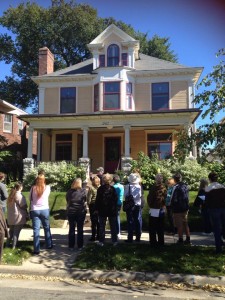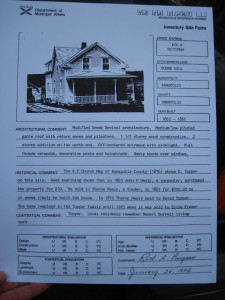
Welcome to the
Healy Project
Join us on Facebook
Send us an Email
Tour Intro to the History of the North Wedge
On Saturday, October 3rd, a beautiful fall day, 26 people walked around the north end of Lowry Hill East. Guided by Anders Christensen, Ezra Gray, and Sean Ryan, they looked at buildings by T,P. Healy and other master builders and architects.
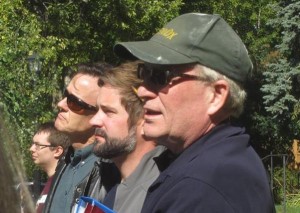
Anders, Sean, Ezra, and a tour-goer examining 2201 Bryant, Healy’s most expensive Wedge house (Photo by Madeline Douglass)
At the end of the tour, they viewed the interior of a restored house designed and built by Healy in 1899. Ironically, forty years ago, this house was bought by Healy Project board member Nathaniel Forbes, who undertook some of the initial restoration projects.
Here is Anders’ introduction to the tour, giving background information about the builders and their houses:
“Theron Potter Healy is Minneapolis’s most famous builder. He was a master builder, coming from a time before academically trained architects. He was a real estate developer, a house designer (often referred to as an architect), and a general contractor, all in one.
Why is he our most famous?
First, Healy was prolific: nearly 200 buildings in a twenty year time span–commercial buildings, our first YWCA, apartment buildings, barns, carriage houses, auto sheds, and all those marvelous houses. The three largest concentrations are in Central (the Healy Block), Lowry Hill, and here in Lowry Hill East/the Wedge. He built for many of the most prominent families; he built for virtually every leading architect, he built in 13 Minneapolis neighborhoods.
Second, since his rediscovery in 1978, he was nicknamed “King of the Queen Anne” by Trilby Busch. The Queen Anne style is what we think of when we talk about a “Victorian” house. We will see some of Healy’s Queen Annes in the North Wedge. The Queen Anne house is romantic, fanciful, curved, ornamented–pre-modern. It reached its peak in 1892.
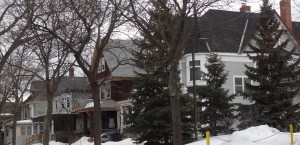
Two of Healy’s Queen Annes on the 2300 block of Colfax Avenue. The Orth House, an 1893 Healy design (far left), was wrecked along with the house next door for an apartment building in February of 2015. (Photo by Trilby Busch)
The Crash of 1893 was the second worst financial panic in American history. It came about because of Wall Street speculation in railroads. Everybody wanted to be a Vanderbilt. The Columbian Exposition of 1893, also known as the Chicago World’s Fair, was centered around the White City emphasized Neo-Classical architecture. The State Buildings presented a variety of American colonial models. After 1893, the Queen Anne was out of date.
–
The Queen Anne did not come back into favor until the late 1960s and 1970s. They were cheap, center city, a repudiation of ’50’s modernity, and adored by gay men.
Third, T. P. Healy’s personal story is compelling. Born in Round Hill, Nova Scotia. His family’s business was the Healy Woodworking Company. Healy did not work in the family business. He made his way to Halifax where he was a merchant and ship owner transporting hardware up and down the New England and Canadian Maritime coast.
His fortune sank with his two ships. The age of the wooden ship was coming to an end. His wife’s health suffered from the cold, damp climate. In 1883 he took his family (wife Mary Ann and eight children–Lena, Alice, Charles, Dora, Erena, Reginald, Birdie May, and Bessie) to Bismarck, Dakota Territories to build schools, houses, and tenements with his older brother Anderson Healy. In 1885, they came to Minneapolis with one additional child, Henry Chester. Healy was forty-one years. He was starting over in a new city. Twenty-one years later in February of 1906, he died of a heart attack while out for an evening stroll. He was sixty-one years old.
On our tour we are going to see a number of houses designed and built by T. P. Healy. We are also going to see the works of three other master builders–Henry Ingham, Henry Parson, and P. C. Richardson, as well as houses designed by such Minneapolis architects as the Orff brothers George and Fremont, Harry Wild Jones, William Kenyon, Edward Stebbins, Walter Keith, James McLeod, Clarence Johnston, William Channing Whitney, Edgar Joralemon, Warren Dunnell, Frederick Clarke, Septimus Bowler, Christopher Boehme, Victor Cordella, Lowell Lamoreaux, Frederick Kees, and Joseph Haley.
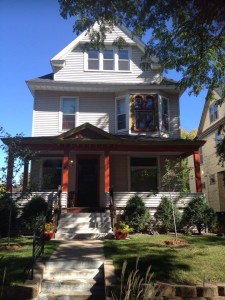
This house designed by P.C. Richardson was made famous by the photo taken on the porch roof of the rock band “The Replacements”–the cover on their “Let It Be” album, released October 1984. (Photo by Nat Forbes)
This tour has three themes:
1. History is stratified. There is not just one past, there are many layers of the past. Understanding our history is important because it helps to orient us.
2. Almost all old buildings are capable of restoration. We will see many examples of this on our tour. We can see beyond condition to understand what once was and to envision what is possible.
3. In Minneapolis, many fine old buildings have been lost by our failure to adaptively reuse them. It is a failure of imagination and political will. It is also the result of a municipal political system corrupted by the financial influence of real estate developers.”
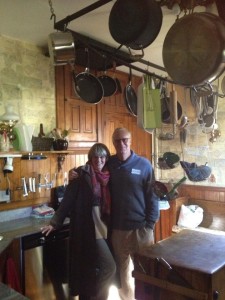
Nat and Stacie Forbes in the kitchen of the Healy house he owned four decades ago. The original cabinets, wainscoting, and a bench he installed are still there.
–T.B.
